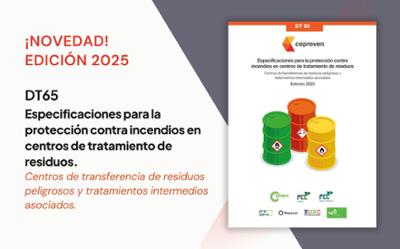

Ensuring fire protection in waste treatment facilities
CEPREVEN provides the keys to preventing any fire-related accidents in waste treatment facilities (CTR).
Active fire protection in waste treatment centres (WTCs) must be based on a risk assessment that takes into account, among other things, the amount of waste, its hazardous characteristics and the way it is stored, according to CEPREVEN's new document.
The new document "DT 65 Specifications for fire protection in waste treatment centres", by CEPREVEN, explains the measures that must be taken into account to protect this type of facility, whose purpose is to group loads, usually from the collection of waste producers, and send them for treatment. In addition, they can perform associated operations, e.g. compaction and crushing. Clean points do not fulfil this function and are therefore outside the scope of this chapter.
The WTCs receive hazardous waste with different characteristics and origins, which they group together on the same pallet or in the same container, an operation that may involve mixing compatible liquids. Once sufficient quantities have been accumulated to make up the loads, they are sent to other treatment facilities authorised for specific wastes. On the one hand, hazardous waste is a category that includes articles that have reached the end of their useful life (lead batteries, lithium or waste electrical and electronic equipment, among others) or packaging that is classified as hazardous due to its content of a known substance. On the other hand, hazardous wastes with a less obvious composition, such as oils, solvents or certain water-based wastes, may need to be tested to confirm their further treatment.
Active protection recommendations
The new CEPREVEN document contains a series of recommendations for this type of centre, both operational and in terms of construction protection, active fire protection and intervention in the event of an incident. As for constructive protection systems, it considers that the new Regulation on the Storage of Chemicals and Instructions (RAPQ), although not applicable to the waste sector, provides adequate instructions for the implementation of active protection systems. And in this area, it points out that "the need for protection must arise from a risk assessment that considers, among other things, the quantity of waste, its hazardous characteristics and the form of storage".
In general terms, the need for "a specific fire protection network, detection systems appropriate to the protected risk, automatic extinguishing systems, and an ATEX study of areas with the presence of waste likely to produce explosive atmospheres" should be analysed. In the first case, it is "a water supply consisting of a pumping unit and water reservoir, and a hydrant network with coverage according to RSCIEI and RIPCI".
As regards detection systems appropriate to the protected risk, "in those cases where the waste is likely to cause fires that develop very quickly (flammable products), it is advisable to use flame detection or thermal video-detection cameras". This type of system can be used both indoors and outdoors. Where slower development is to be expected, indoors, systems with smoke detection technology can be installed. On the other hand, it points to the need for "installation of manual alarm buttons, both indoors and outdoors".
Automatic extinguishing systems
In relation to automatic extinguishing systems, they are considered essential for all indoor storage of flammable waste above 2.7 metres in height. "Achieving an efficient extinguishing system depends on many factors: type of product, type and volume of container, storage configuration (type of storage, stacking height, etc.)". The design of the system must be based on a recognised standard. "NFPA 30 offers a wide range of solutions for different flammable product storage configurations, based on sprinklers". For their part, solutions based on high-expansion foam may be suitable, although the limitations of the different standards regarding the protection of polar solvents or the installation height of the generators must be taken into account. "These circumstances may lead to further destruction of the foam, which would require a compensating factor. Standards such as NFPA 11, UNE-EN 13565-2, or APSAD R12 are considered suitable for design".
When establishing manual or automatic means of fire protection, it should be taken into account that certain residues may be reactive with water. "These wastes should be stored separately, and if necessary because of their volume, extinguishing systems based on powder or gaseous agents should be considered".
Finally, the document refers to the ATEX study of areas with the presence of waste likely to produce explosive atmospheres. "A non-exhaustive list of such areas may include: storage areas, loading/unloading areas, the vicinity of flammable transfer pumps, or product repackaging areas". The survey shall consider the foreseeable leakage or spillage and, together with the ventilation circumstances, classify the area within a certain radius of the leakage point. Equipment used in these zones shall be compatible with the type of ATEX zone defined.
The implementation of these measures can be considered favourably to increase storage capacity or to reduce safety distances between different areas.





